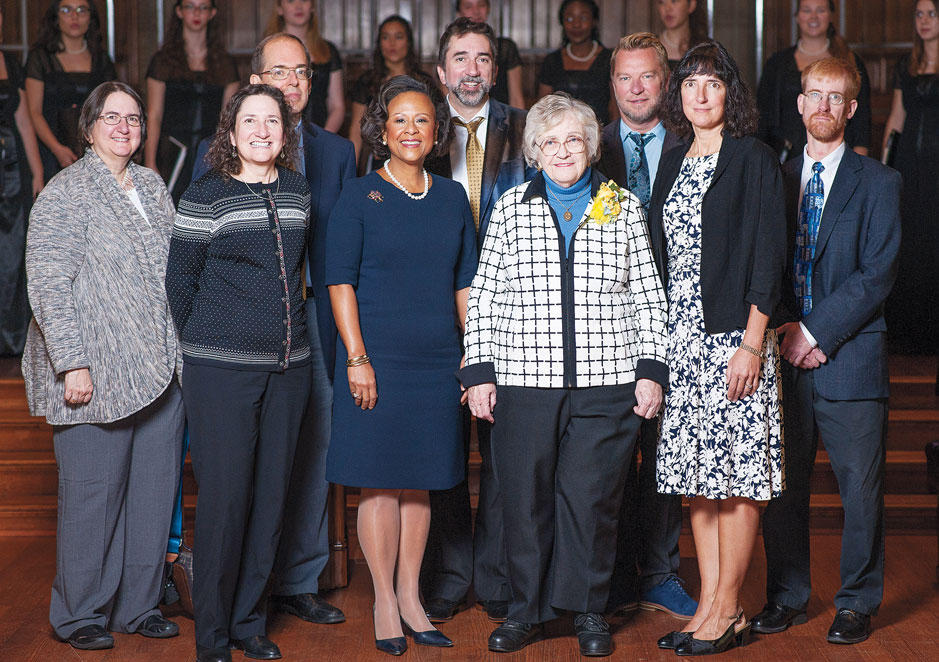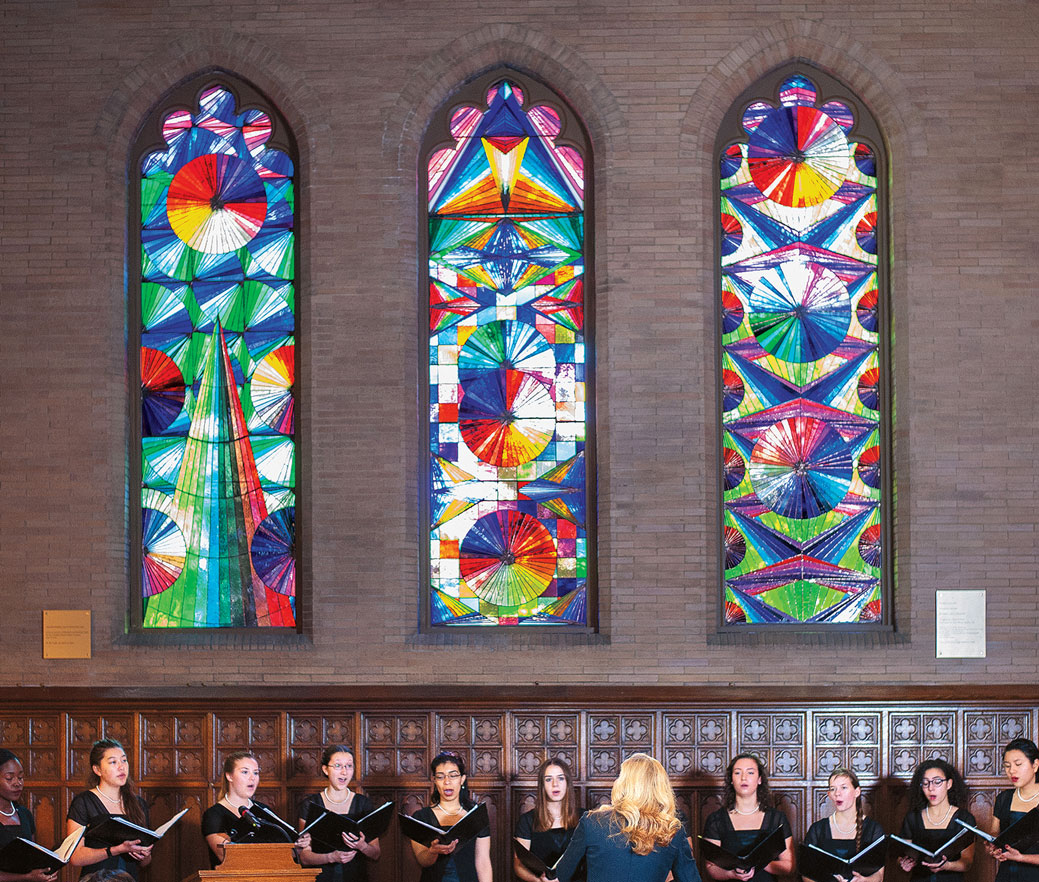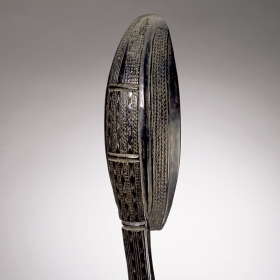Photo by Shawn Cooper
Unabashedly bright and multicolored, the new set of stained glass windows in Houghton Memorial Chapel calls to mind a kaleidoscope with its bursts of geometric patterns. The windows bring an exuberant sensibility into the chapel, one that gives expression to the diversity of life experiences and beliefs that exist on campus.
The windows, given by Patricia Kopf Colagiuri ’55 in memory of her parents, Elizabeth and Rudolph Kopf, are a departure from the chapel’s existing windows. They were designed by artist Jeffrey Gibson (b. 1972), a member of the Mississippi Band of Choctaw Indians and of Cherokee descent, with Southern Baptist roots (his two grandfathers were ministers), and assembled in part by women weavers of Mayan ancestry in Guatemala.
This commission was Gibson’s first foray into stained glass. He trained as a painter and has more recently worked in beads and in textiles. In his 20s, he was struck by the similarities between geometric abstraction in modern art and indigenous art.
In many houses of worship, stained glass traditionally depicts biblical themes, historical figures, or religious symbols. Gibson’s designs for the new windows dispense with representationalism altogether. Instead, he uses geometric abstraction: circles, triangles, and squares. These shapes convey cultural meaning across many different societies. So the windows, by being nonrepresentational, leave interpretation to the viewer.

Patricia Kopf Colagiuri ’55 (center) with her family, including Wellesley daughters Jennifer Colagiuri Eccles ’81 and Elizabeth Colagiuri McClung ’85, and President Johnson at the dedication of the windows

The three windows: To Become Day, Mean Solar Day, and Evening Civil Twilight

Artist Jeffrey Gibson at the window dedication.
Photo by Aniqa Hassan ’20
The triptych is part of an ongoing effort to make the chapel space more welcoming to everyone. In a newsletter announcing the new windows, Dean of Religious and Spiritual Life Tiffany Steinwert aptly described the challenge: “… many colleges and universities—daunted by the conflict between monofaith institutional history and multifaith contemporary community—responded by de-emphasizing religious and spiritual dimensions altogether … . Wellesley has embraced, explored, and fostered the ideals and practices of a truly diverse multifaith community.”
In 2012, a new stained glass window designed in the traditional style was installed in the chapel. The graceful Veritas window, with the allegorical figure of Truth represented by a woman of African ancestry, also depicts symbols of the world’s religions.
For the new triptych, the committee formed to shepherd its development decided to commission a contemporary artist. “It was love at first sight with Jeffrey,” says Daniela Rivera, associate professor of art and a member of the committee. “He was such a good listener and so articulate about his work.”
Gibson needed guidance to translate his design into the language of stained glass. Enter Lyn Hovey, president of Lyn Hovey Studio in Norton, Mass., and a longtime expert in stained glass. “It’s like a composer writing for an instrument he doesn’t know,” Hovey says of an artist moving from painting to stained glass. “But Jeffrey was very open to learning.”
‘The windows place indigenous and Christian traditions in a creative conversation of light and shadow that brings Wellesley’s multifaith vision to life.’
—Tiffany Steinwert, Dean of Religious and Spiritual Life
Usually, an artist will turn over his design to the stained-glass studio to complete. But Hovey encouraged Gibson to participate in the selection of the glass itself. Working with a range of more than 300 colors of mouth-blown glass from Europe, Gibson spent hour upon hour at a light table choosing colors. He obtained an even wider array of colors by layering: The glass ranges from one to three layers thick. He later traveled to Hovey’s studio in Guatemala, where a “sky platform” was erected that enabled the artist to lie on the floor and look up through the layers of glass before they were soldered together. This process enabled him to see the design in a manner that more closely resembled the effect of light through the chapel windows.
In Guatemala, Hovey’s crew and a quartet of indigenous women—chosen because of their dexterity in weaving—completed the work on the designs. In all, more than 5,000 pieces of glass were used in the three windows. At Wellesley, experts from Hovey’s studio installed the triptych.
At the dedication ceremony, Gibson and Hovey spoke about how the windows capture the changes in light throughout the day, and over the seasons. The designs reflect, and respond to, the cyclical nature of darkness and light, despair and hope, stasis and transformation.
“The windows place indigenous and Christian traditions in a creative conversation of light and shadow that brings Wellesley’s multifaith vision to life,” Steinwert says.
Rivera agrees. “These windows, created by all these diverse groups, embody the diversity of the College,” she says. “The collaboration that went into their making transformed our mandate in a way that was surprising and even more giving than we had asked for.”
Some visitors to the chapel might be taken aback by the colors and abstract nature of the windows, especially in such a traditional setting. Some might prefer a quieter religious experience than the “ecstatic spirituality” Gibson hoped to convey.
Hovey says there’s room for both experiences. “There are different ways to express the most spiritual aspects of our lives. Ancient peoples made cave paintings and told stories through them. The Maya tell stories through their sculpture. One couldn’t say that the Pietà [by Michelangelo] is any more spiritual than the cave painting. It’s just that there are different ways to capture it.”







We ask that those who engage in Wellesley magazine's online community act with honesty, integrity, and respect. (Remember the honor code, alums?) We reserve the right to remove comments by impersonators or comments that are not civil and relevant to the subject at hand. By posting here, you are permitting Wellesley magazine to edit and republish your comment in all media. Please remember that all posts are public.